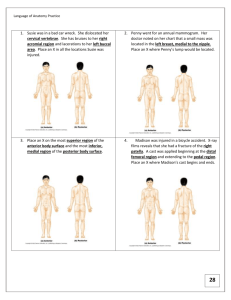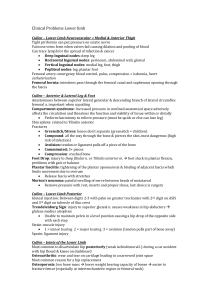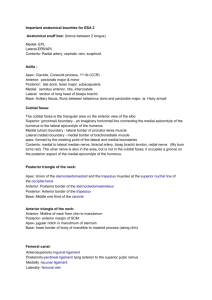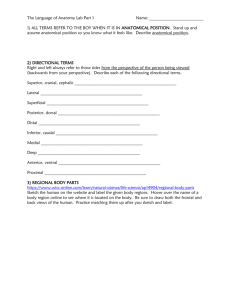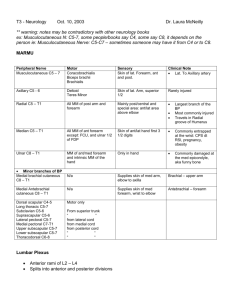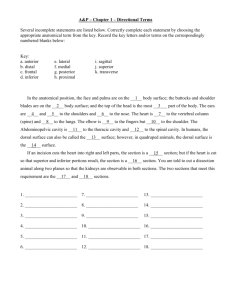Muscular Skeletal Quiz 2
advertisement
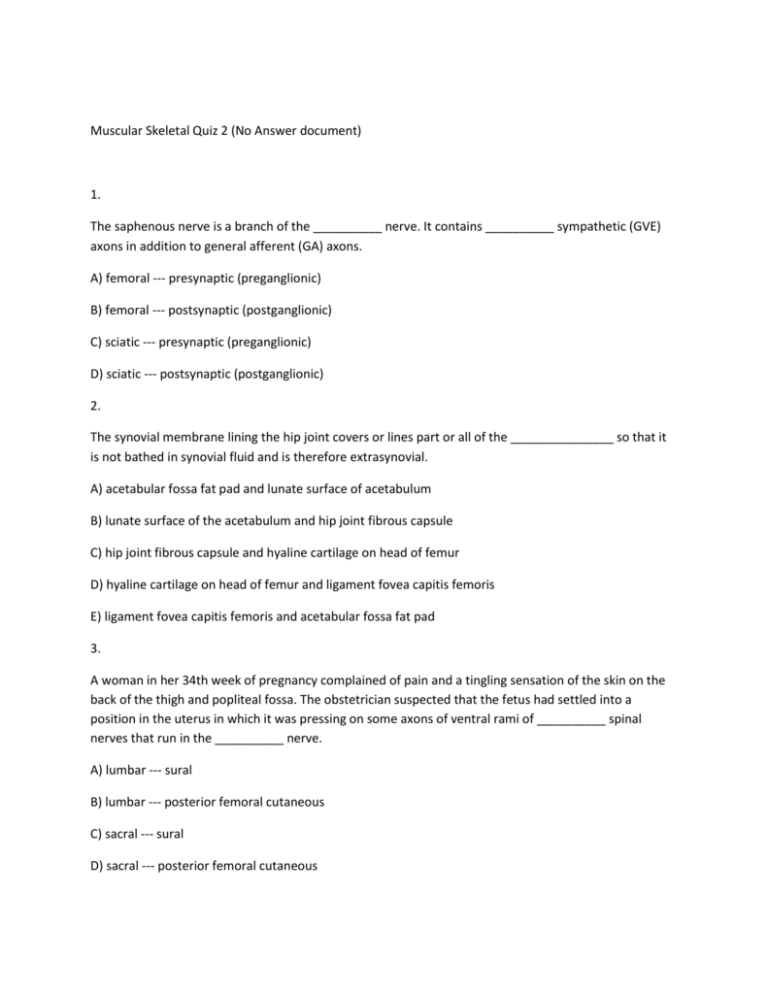
Muscular Skeletal Quiz 2 (No Answer document) 1. The saphenous nerve is a branch of the __________ nerve. It contains __________ sympathetic (GVE) axons in addition to general afferent (GA) axons. A) femoral --- presynaptic (preganglionic) B) femoral --- postsynaptic (postganglionic) C) sciatic --- presynaptic (preganglionic) D) sciatic --- postsynaptic (postganglionic) 2. The synovial membrane lining the hip joint covers or lines part or all of the _______________ so that it is not bathed in synovial fluid and is therefore extrasynovial. A) acetabular fossa fat pad and lunate surface of acetabulum B) lunate surface of the acetabulum and hip joint fibrous capsule C) hip joint fibrous capsule and hyaline cartilage on head of femur D) hyaline cartilage on head of femur and ligament fovea capitis femoris E) ligament fovea capitis femoris and acetabular fossa fat pad 3. A woman in her 34th week of pregnancy complained of pain and a tingling sensation of the skin on the back of the thigh and popliteal fossa. The obstetrician suspected that the fetus had settled into a position in the uterus in which it was pressing on some axons of ventral rami of __________ spinal nerves that run in the __________ nerve. A) lumbar --- sural B) lumbar --- posterior femoral cutaneous C) sacral --- sural D) sacral --- posterior femoral cutaneous E) both lumbar and sacral --- sural F) both lumbar and sacral --- posterior femoral cutaneous 4. The ___________ nerves should be anesthetized if a patient is having surgery on the dorsal and plantar surfaces of digits 3 and 4 in the foot. A) femoral and deep fibular (peroneal) B) deep fibular (peroneal) and tibial C) tibial and superficial fibular (peroneal) D) superficial fibular peroneal)and sural E) sural and femoral 5. Medial rotation of the femur on the tibia as the knee joint locks into full extension is due to the _____________. The locked extended knee can be maintained for some time by the _____________ ligaments without contraction of any muscles. A) contraction of the popliteus muscle --- collateral B) contraction of the popliteus muscle --- cruciate C) longer length of the medial femoral condyle --- collateral D) longer length of the medial femoral condyle --- cruciate E) contraction of the quadriceps muscles --- collateral F) contraction of the quadriceps muscles --- cruciate 6. Imagine an image from an MR scan of a normal ankle and foot acquired in the sagittal plane through the big toe (hallux). The __________ tarsal bone will be located most superiorly on the image. A) navicular B) medial cuneiform C) talus D) calcaneus 7. The tendon of the tibialis anterior muscle can be palpated at the ankle when the patient is asked to _______ against resistance. A) plantarflex and invert B) plantarflex and evert C) dorsiflex and invert D) dorsiflex and evert 8. A blow on the patellar tendon (ligament) elicits a knee jerk reflex. This is a functional test for spinal nerve __________ spinal levels. A) L1 & L2 B) L3 & L4 C) L5 & S1 D) S2 & S3 9. Knee injury often results in tears of a ligament and/or a meniscus because the ___________ meniscus is attached to the inner surface of the ________ ligament. A) lateral --- oblique popliteal B) medial --- tibial (medial) collateral C) medial --- anterior cruciate D) lateral --- fibular (lateral) collateral E) lateral --- posterior cruciate 10. A sudden occlusion of the deep artery of the thigh (profunda femoris) just proximal to the first perforating artery would severely compromise blood supply to the A) anterior compartment of the leg. B) knee joint. C) hip joint. D) adductor magnus muscle. 11. Ventral roots of spinal nerves L2 and L3 were damaged during a spinal tap. This patient most likely experienced difficulty in ________ on the affected side. A) dorsiflexing the foot B) flexing at the hip joint C) abducting at the hip joint D) laterally rotating the thigh at the hip joint 12. A poorly placed injection of medication was made into the right gluteal region of a patient. The error was revealed later when the patient stepped forward and her hip sagged on the __________ side because the _________ muscle was partially paralyzed on the side of the injection. A) left --- quadratus femoris B) left --- gluteus medius C) right --- quadratus femoris D) right --- gluteus medius 13. This is an MR image of a normal knee in the coronal plane. The arrows indicate the ______________ cruciate ligament. When skiing downhill, this ligament ______________ prevent the femur from sliding forward on the tibia when the knee is flexed. A) anterior --- would B) anterior --- would not C) posterior --- would D) posterior --- would not 14. The ________________ muscles both contribute to flexion of the leg at the knee joint. A) gracilis and adductor magnus B) adductor magnus and biceps femoris C) biceps femoris and soleus D) soleus and semimembranosus E) semimembranosus and gastrocnemius 15. A loop of small intestine has pushed through the femoral ring from the abdomino-pelvic cavity to enter the thigh. This herniated sac compresses a structure that lies directly lateral to it. This is likely to A) obstruct drainage of the great saphenous and deep femoral veins and cause edema. B) cause numbness and tingling of the skin on the anterior and medial thigh. C) obstruct blood flow to pectineus, iliopsoas and quadriceps femoris. D) obstruct blood flow to the posterior compartment of the thigh. E) cause weakness of the adductor muscles. 16. A catheter can be inserted into the femoral artery at the base of the femoral triangle. The artery can be located inferior to the ____________. Distal to the apex of the femoral triangle, the femoral artery is not easily accessible because it lies posterior to sartorius and _________. A) midpoint between the anterior superior iliac spine and the pubic tubercle --- vastus medialis B) midpoint between the anterior superior iliac spine and the pubic tubercle --- adductor longus C) pubic tubercle --- vastus medialis D) pubic tubercle --- adductor longus E) anterior superior iliac spine --- vastus medialis F) anterior superior iliac spine --- adductor longus 17. A child playing outdoors steps on a nail and the wound becomes infected. The infection enters lymph vessels on the lateral side of his heel. The first palpable nodes that could become inflamed are the __________ nodes. If the infection continues along the usual lymphatic trajectory the last (terminal) nodes it reaches before entering the thoracic duct are the ________ nodes. A) superficial inguinal --- lumbar (lateral aortic) B) superficial inguinal --- deep inguinal C) popliteal --- lumbar (lateral aortic) D) popliteal --- deep inguinal 18. When the tendon of the __________ muscle is completely torn, the patient’s foot is easily dorsiflexed beyond the usual limit and is unable to plantarflex against resistance. A) fibularis (peroneus) tertius B) extensor digitorum longus C) tibialis anterior D) gastrocnemius/soleus 19. Most ankle sprains are due to over-inversion with an accompanying tear of the A) plantar calcaneonavicular (spring) ligament. B) anterior talofibular ligament. C) medial (deltoid) ligament. D) calcaneal tendon (Achilles). 20. Excessive torsion of the tibia and/or femur may result in A) bowleggedness. B) osteoarthritis. C) a fibular fracture. D) avascular necrosis of the femoral head. 21. A branch of the ____________ artery travels through a foramen formed by the ____________. A) obturator --- ligament to the head of the femur B) obturator --- acetabular labrum C) medial femoral circumflex --- ligament to the head of the femur D) medial femoral circumflex --- acetabular labrum 22. Computerized tomography (CT) is a modality that __________ employ ionizing radiation. Using this modality, structures __________ be superimposed on the image. A) does --- will B) does --- will not C) does not --- will D) does not --- will not 23. Imagine an MR image in the coronal plane through the hip joints. The __________ will be located superiorly and medially to the __________. A) femoral head --- greater trochanter B) vastus lateralis muscle --- adductor magnus muscle C) lesser trochanter --- acetabulum D) gluteus medius muscle --- gluteus minimus muscle 24. This is an image from an MRI of the ankle in the sagittal plane. The asterisks indicate the A) superficial fascia. B) deltoid ligament. C) tibialis posterior tendon. D) calcaneal (Achilles') tendon. 25. Destruction of the superior gluteal nerve disturbs the normal gait by paralyzing the ___________ muscle. A) piriformis and tensor fascia lata B) tensor fascia lata and gluteus medius C) gluteus medius and gluteus maximus D) gluteus maximus and superior gemellus E) superior gemellus and piriformis 26. If popliteal lymph nodes are enlarged, the __________ is most likely infected. A) big toe B) lateral side of the leg C) skin over the medial malleolus D) posterior thigh 27. An intramuscular gluteal injection was improperly administered, causing damage to the sciatic nerve. This may result in A) an inability to extend at the knee joint. B) the total loss of sensation below the knee. C) the loss of sensation on the sole of the foot. D) an inability to flex at the hip joint. 28. The ________ muscle can assist in plantarflexion at the ankle because its tendon passes ________ to a coronal plane between the lateral and medial malleoli. A) fibularis (peroneus) longus --- anterior B) fibularis (peroneus) longus --- posterior C) tibialis anterior --- anterior D) tibialis anterior --- posterior 29. A stab wound completely severed the superficial fibular (peroneal) nerve at its origin. This would result in A) numbness over the medial leg. B) numbness in the first interdigital space. C) severe weakness in eversion. D) loss of plantarflexion. 30. The posterior crural compartment is divided into deep and superficial regions by a deep transverse fascia (septum). Deep to this transverse fascia is the compartment that contains the A) posterior tibial vessels and soleus muscle. B) soleus muscle and tibial nerve. C) tibial nerve and flexor digitorum longus. D) flexor digitorum longus and small saphenous vein. E) small saphenous vein and posterior tibial vessels. 31. During a car crash a teenager suffered a posterior dislocation of the head of the femur out of the acetabulum. This happens when the hip joint is in an unstable position and ligaments tear and/or stretch. At the time of impact, the most likely position of the thigh was __________ at the hip joint. A) flexed, adducted and medially rotated B) fully extended and abducted C) in anatomical position 32. The major anastomosis that connects the internal iliac and femoral system of arteries is the anastomoses of the medial and lateral femoral circumflex arteries with the _________ artery. This anastomosis is responsible for successful healing of ____________ fractures of the femoral neck. A) first perforating --- intracapsular B) first perforating --- extracapsular C) inferior gluteal --- intracapsular D) inferior gluteal --- extracapsular 33. In a standing position, the patella articulates mostly with the _____________ condyle. A) medial femoral B) lateral femoral C) lateral tibial D) medial tibial 34. The plantar calcaneonavicular (spring) ligament bridges the _________________ joint thereby supporting the ____________ longitudinal arch. A) subtalar --- medial B) subtalar --- lateral C) calcaneocuboid --- medial D) calcaneocuboid --- lateral E) talocalcaneonavicular --- medial F) talocalcaneonavicular - lateral 35. In a CT (axial) image of the knee at the level of the femoral condyles, the __________ will be the most lateral structure in the list below. A) lateral head of the gastrocnemius B) anterior cruciate ligament C) lateral femoral condyle D) popliteal artery E) biceps femoris Questions 51 & 52 refer to the above diagram showing relationships at the ankle. 36. This is an arteriogram of the proximal left lower extremity in an AP projection. The __________ is indicated by the white circle. A) deep artery of the thigh (profunda femoris) B) femoral artery C) popliteal artery D) lateral femoral circumflex artery 37. The second lumbar spinal nerve roots are the first to be injured by herniation of the intervertebral disc between vertebrae A) T12/L1 B) L1/L2 C) L2/L3 D) L3/L4 38. The _________ does NOT have lymph vessels. A) biceps femoris B) skin C) spinal cord D) superficial fascia 39. The dermatome that extends downward from the neck to include the skin over the shoulder (acromion & upper deltoid) is __________. These axons are carried by the __________ nerve. A) C4 --- supraclavicular B) C4 --- axillary C) C5 --- supraclavicular D) C5 --- axillary 40. The patient is so thin you can see his ribs and intercostal spaces. When he breathes, the intercostal space between the right 3rd and 4th ribs "sucks in" and "blows out". Electromyography shows no electrical activity from the intercostal muscles in that space. The muscles in all other intercostal spaces are normally active so that the integrity of the other spaces is maintained during breathing. When you perform a sensory test you should expect __________ the third intercostal space. A) anesthesia of the skin over B) anesthesia of the skin over the inferior half of C) anesthesia of the skin over the superior half of D) no loss of sensation over 41. Both the ___________ muscles attach to both axial and appendicular parts of the skeleton. A) piriformis and iliopsoas B) iliopsoas and rectus femoris C) rectus femoris and pectineus D) pectineus and quadratus femoris E) quadratus femoris and piriformis
